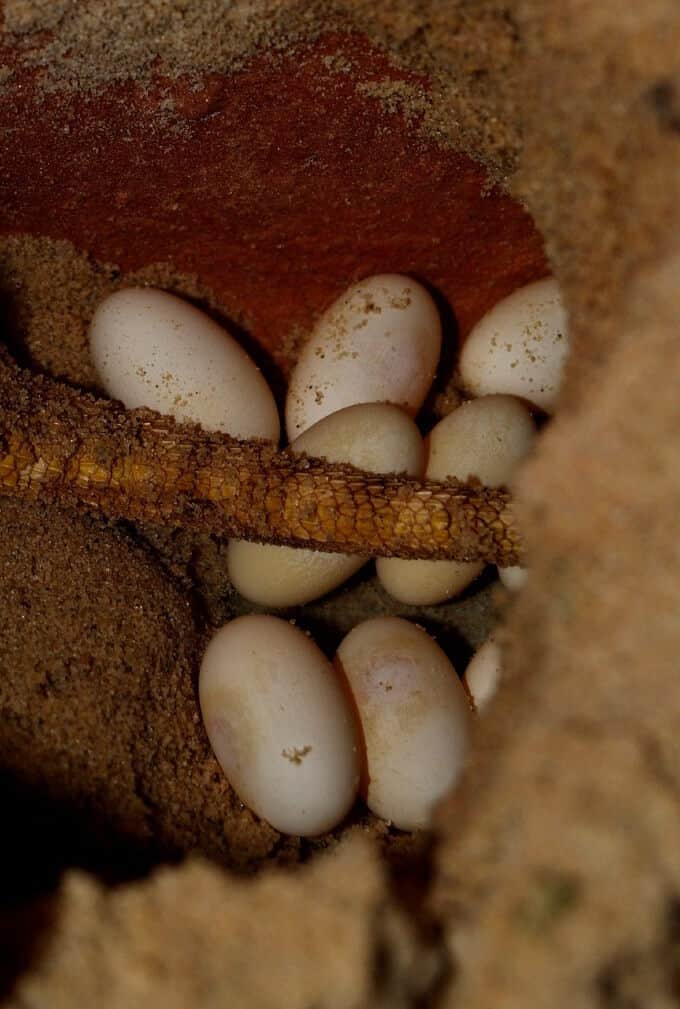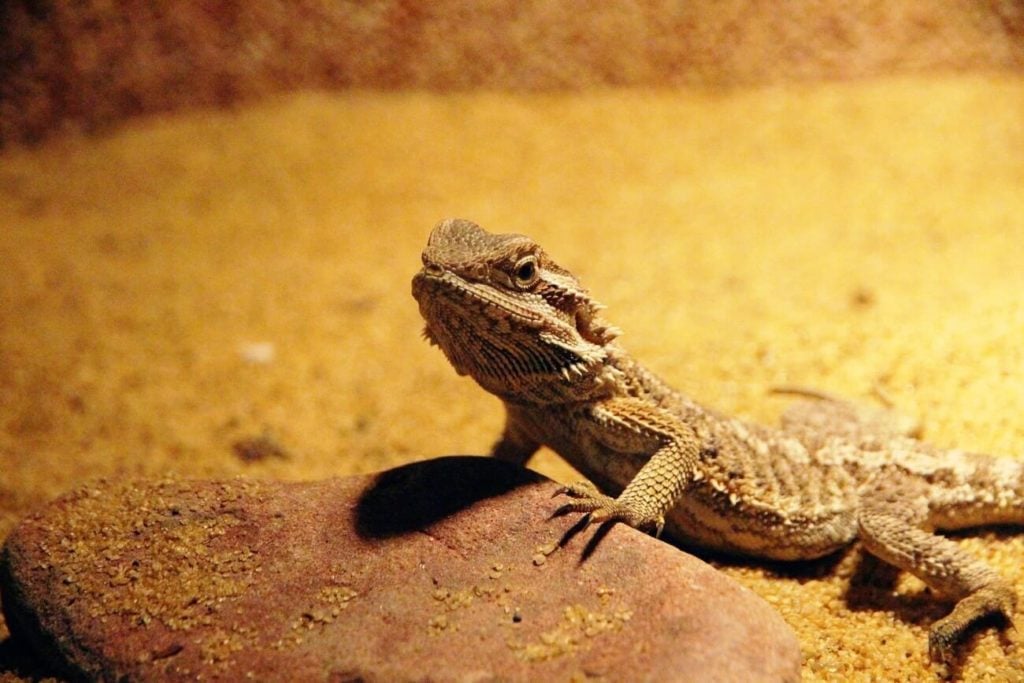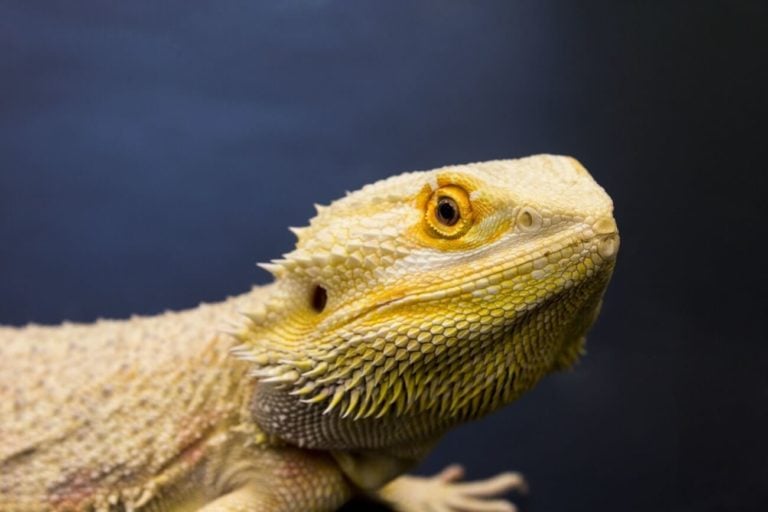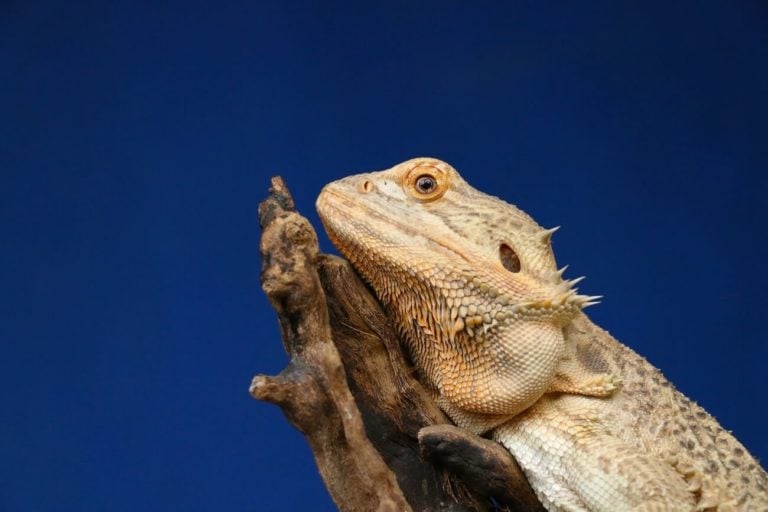There’s a lot to learn when it comes to bearded dragon eggs. As an owner, you should understand how to incubate them and how to tell if the eggs are fertile or not (among other things).
It can all seem a bit intimidating at first.
But don’t worry, it’s not nearly as tough as it seems. As long as you take a few minutes to learn the basic principles of the egg-laying and development process you’ll be just fine!
Table of Contents
Signs That A Bearded Dragon Is Ready To Lay Eggs
Contrary to popular belief, your female bearded dragon doesn’t have to have a male around to lay eggs. Like chickens, bearded dragons are fully capable of laying infertile eggs. Even being around males for a brief period could trigger the egg-laying process.
If your bearded dragon was around a male at any point in the last year, there’s also the chance that her eggs could be fertilized. Females can hold onto sperm for up to a year until she’s ready to lay eggs.
This can happen as early as 10 months old to several years into adulthood.
Whatever the case may be, there are several signs that your bearded dragon is ready to lay eggs. When a female is developing eggs she has not yet laid, she’s referred to as being gravid.

Gravid females often exhibit strange behaviors as the eggs grow inside her. They often become lethargic and spend more time basking under the heat lamp. The egg-laying process takes a physical toll on the lizard, so you might see her eat less food or have more frequent bowel movements.
It takes around three weeks for the eggs to develop inside her. During the latter part of this stage, you’ll notice her belly getting bigger. When she’s getting ready to lay those eggs, you’ll be able to see and feel them under her skin.
At this point, her behavior will get more erratic. She will start to look for a place to lay the eggs. She might start digging into the substrate frantically or clawing at the corners of the enclosure.
This is because her eggs are coming and she wants to prepare!
How Many Eggs Do They Lay?
Bearded dragons can lay up to 20 eggs at once. A single group of eggs is referred to as a clutch.
Expert Tip: Once the female is done laying her clutch of eggs, there may be more to come! Bearded dragons can lay several clutches over the course of a few months.
How To Incubate Bearded Dragon Eggs
If your bearded dragon lays eggs, you must do what you can to help the process along. These lizards can experience several issues during the birthing process.
Not only that, but they may start to eat their eggs to replenish some of those nutrients they lost when they were gravid.
Whether you’re on your first successful breeding attempt or the eggs came as a surprise, here are some things you should do to incubate and care for the eggs.
1. Provide A Place For The Female To Lay Her Eggs
First things first, you have to give your bearded dragon the means to lay the eggs safely.
As we mentioned earlier, females will start searching for a place to lay their eggs when the time gets close. A standard enclosure is not always the best place to lay the eggs.
Bearded dragons like to tunnel a hole and bury their eggs. Chances are, there’s not enough depth in her standard enclosure to do this.
This means you’ll need to create a nesting box.
Fill a small plastic container with about five to six inches of substrate. You can use reptile dirt or vermiculite. Moisten the substrate with some water. This will raise the humidity levels of the environment.
You should moisten the substrate enough so that it clumps up a bit. But, don’t soak it and leave standing water. This will only cause mold issues.
Now, place the nesting box into her enclosure. Make sure that the heat lamps are on to keep the box warm.
You can also create a separate nesting enclosure. Just make sure that you’re giving the new environment and substrate a chance to warm up before putting her inside.
Once your bearded dragon is done laying her eggs, you can remove her from the enclosure. Make sure that you’re providing her with plenty of food and fresh water. She’s going to need some time to replenish her body after the ordeal.
Expert Tip: Offer her some high-protein snacks and dust any food with calcium. Bearded dragons pull calcium from their skeletons when developing eggs, so high-calcium foods are a must.
2. Place The Eggs In An Incubation Box
You can keep the eggs in the nesting box, but this requires continual monitoring to keep humidity levels and temperatures at a safe level. This is no easy task, so most breeders will simply use an incubator.
Before placing the eggs into the incubator, you must move them to a separate incubator box. This can be a simple plastic container with a snug lid.
Expert Tip: Don’t poke any holes in the container. You want the humidity levels to rise inside.
Line the bottom of the box with an inch or two of the incubation medium. You can use a commercial incubation substrate. Many breeders also like to use perlite or vermiculite.
The incubation medium will hold onto moisture to keep humidity levels constant. Don’t forget to moisten the medium a bit!
Create a small divot in the substrate so that the eggs can rest in it without rolling over. Arrange the eggs so that they’re about two to three centimeters apart. This will provide ample room for growth as the eggs develop even further.
3. Put The Box In An Incubator
Now, it’s just a matter of moving the prepared incubator boxes to your incubation machine. Before you do that, you’ll need to set the machine correctly.
Temperatures should be between 80 and 85 degrees Fahrenheit. Around 84 degrees is a good average to aim for. Slight fluctuations here and there are fine as long as the incubator sticks within the acceptable range.
Humidity levels should be high as well. Aim for around 75 percent. Check the temperature and humidity levels regularly to ensure that the environment is stable.
4. Monitor The Eggs During Incubation
All you can do now is wait and monitor the eggs as they develop. Bearded dragon eggs will take anywhere between 55 and 75 days to hatch. During this lengthy incubation period, you must make sure that the eggs are developing properly.
In addition to keeping an eye on temperature and humidity, you’ll need to look out for mold. You can wipe away any condensation on the incubation box lids. But, you have to make sure that the excess moisture isn’t falling onto the eggs.
Mold develops when there’s too much moisture in the environment. As long as you maintain humidity levels and be careful about how you clean off condensation, you shouldn’t have to worry about mold.
If you’re not sure if the eggs are fertilized, you can check for an embryo after about a week or two. Known as candling, this process is very simple. However, you must be extra careful.
Rough handling of the eggs can kill the embryo inside, so be very gentle. Simply lift the egg and shine a bright light behind it.
Here’s the one we use:
- Mini penlight gives out max 150 lumens
- Small and light enough to slip into a pocket
- Effective battery light with multiple hours of continuous use
- Comes with 100% satisfaction guarantee
If you see a small developing embryo with veins, the egg has been fertilized. If you don’t, it’s not fertilized and you can remove it (we cover some more details on this technique at the end of the guide).
5. Prepare For Hatching
Now comes the fun part: hatching! After about two months of development, the tiny bearded dragons inside will be ready to hatch from their eggs. There’s not much that you can do to prepare other than continue maintaining the incubation environment.
What To Do During The Hatching Process
It’s tempting to try and help the little lizards come out of their shell. However, you should treat this as a hands-off process.
This means you can sit back and enjoy the miracle of life happening in front of you!

The hatchlings will usually come out head-first. They will struggle, but this is perfectly normal. Let them conquer this first step of life on their own!
Once the hatchling has fully emerged from the shell, you might see a small yolk sac attached to the body. This is what provides the baby lizard its nutrients immediately after hatching. It will shrivel up and fall off once the lizard has absorbed its nutrients.
Leave the hatchlings in the incubation box for the rest of the day. The eggs will hatch at different times. Allowing the already-hatched lizards to roam around the box will stimulate the other eggs to hatch.
Once they’re all out and roaming around, you can remove them from the incubation box and put them in their new home!
What To Do If The Female Is Egg Bound
Also known as dystocia, female bearded dragons can become egg bound. This is when she is unable to lay her eggs. Unfortunately, this is a pretty common occurrence.
There are several reasons why bearded dragons become egg bound. Oftentimes, it’s due to a lack of exercise and proper nutrition. Gravid females need a nutrient-rich diet to stay healthy during the egg development cycle.
When they’re not getting the nutrients they need, their bodies will shut down. She’ll be too weak to lay her eggs.
Egg binding is a serious and potentially life-threatening problem. It can also lead to a shorter life expectancy for beardies that make it through this. Those eggs have to come out somehow. Otherwise, she could develop sepsis and die.
Don’t ignore this problem. If your bearded dragon doesn’t lay her eggs within 45 days, you need to take her to a vet immediately. The vet will perform tests to diagnose the problem. Treatment options vary based on the severity of the issue.
Expert Tip: Sometimes, vets can use hormone-based treatment to get her to lay her eggs. If that doesn’t work, surgical intervention may be necessary.
How To Tell If Bearded Dragon Eggs Are Fertile
In order to tell if bearded dragon eggs are fertile or not, you’ll need to wait until they are at least a couple of weeks old. Attempting to check this when they’re younger is pointless since there won’t be enough development to tell the difference!
Once they’ve reached the two week age you can check if they’re fertile by holding a light to them. Simply lift the eggs out one by one (do this very gently) and hold them against a strong flashlight.
- Mini penlight gives out max 150 lumens
- Small and light enough to slip into a pocket
- Effective battery light with multiple hours of continuous use
- Comes with 100% satisfaction guarantee
This will illuminate the inside of the egg and allow you to tell if the bearded dragon eggs are fertile or not. What you’re looking for is the presence of veins.
Expert Tip: If you don’t see any veins in the egg, continue to incubate them and give them a few more days. There’s are always late bloomers!
If you exceed the three-week mark and still don’t see any veins, there’s a good chance that the egg is infertile.
Now You’re Ready
Now that you’ve read this guide about bearded dragon eggs (and how to manage them), you’re all set!
Once you go through the process once or twice the entire process will become second nature to you. And if you ever get stuck, simply return to this page for a refresher.




